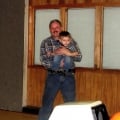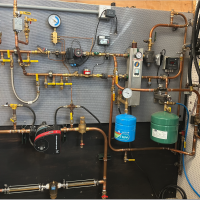Forced hot water heat register part
hi, this is my first post and I hope I'm putting it in the right place. My son lives in NJ and he found a corroded area on his heat register. I'm wondering if anyone can tell me what the name of the part is that I will be trying to fix when I visit him. I can fix some things but plumbing is certainly not my specialty. Any help would be appreciated.
Steve
You can know somethings about somethings but not everything about everything
Comments
-
-
It is one piece 3/4" disc type auto vent . Looks like it has been leaking for years , I assume because no one wanted to replace it . Removing the vent may damage the convector . Replacing the convector may be a safer bet ..
There was an error rendering this rich post.
0 -
Okay, thanks for the info guys. That'll give me a good start in finding what I need
You can know somethings about somethings but not everything about everything
0 -
That air vent should come out of that convector with a little bit of armstrong power and 2 wrenches. There is a substantial flat on the convector for a large flat adjustable wrench to use as a "hold back" while the 14" pipe wrench eases out the vent.
My experience is that the metal of the vent and the metal of the convector do not rust together since they are dissimilar metals. They will be tight but not impossible to remove.
Youy must drain water from the system below the hight of that convector first. Then remove the vent. You may need to add some additional pipes to the handle end of the wrenches for leverage/mechanical advantage. then replace the vent with something like this with a bushing to fit the convector threads https://www.supplyhouse.com/Caleffi-502043A-MINICAL-Automatic-Air-Vent-w-Hygroscopic-Safety-Air-Vent-Cap-1-2-NPT
Once that is replaced with proper pipe thread sealant, you will need to fill the system with water again, to about 12 PSI on the boiler gauge.
Edward Young Retired
After you make that expensive repair and you still have the same problem, What will you check next?
1 -
There also may be isolation valves at the convector, especially if this is commercial. i can't see any in your pictures but you don't have all of it in your picture.
0 -
This unit is in my son's house in New Jersey (built early 1900s). Ed, thanks for all your guidance on this. Because I'm a dad my son looks to me to know how to fix everything and I hate to just shrug and say "Hire somebody." That unit is on the 2nd (top) floor so draining below it won't be a problem. After doing some research am I correct in my assumption that the rusted lump next to the air vent is the wall bracket that holds the unit up? Should I plan to replace that?
And thanks to all of you guys for your help and input. It's great to have a place to go for some solid advice from people who care enough to give it and aren't selling something.
Steve
You can know somethings about somethings but not everything about everything
0 -
If the bracket is no longer supporing the convector you may need to fabricate something. it looks like the bracket is part of the convector cabinet and was spot welded at the factory.
0 -
You will need to drop the boiler pressure to 0 psi.
I would check to make sure the bleeders are working on the other rads because you might need to bleed them when the work is done.
And tighten the vent cap when done bleeding
0
Categories
- All Categories
- 86.7K THE MAIN WALL
- 3.1K A-C, Heat Pumps & Refrigeration
- 56 Biomass
- 423 Carbon Monoxide Awareness
- 104 Chimneys & Flues
- 2K Domestic Hot Water
- 5.6K Gas Heating
- 103 Geothermal
- 158 Indoor-Air Quality
- 3.5K Oil Heating
- 68 Pipe Deterioration
- 938 Plumbing
- 6.2K Radiant Heating
- 385 Solar
- 15.3K Strictly Steam
- 3.4K Thermostats and Controls
- 54 Water Quality
- 43 Industry Classes
- 47 Job Opportunities
- 18 Recall Announcements










